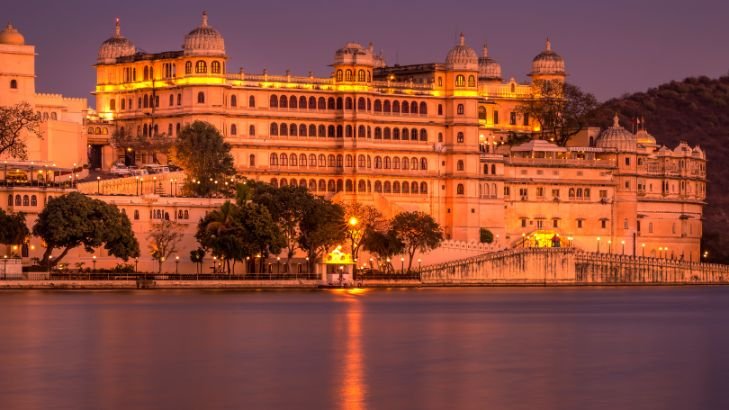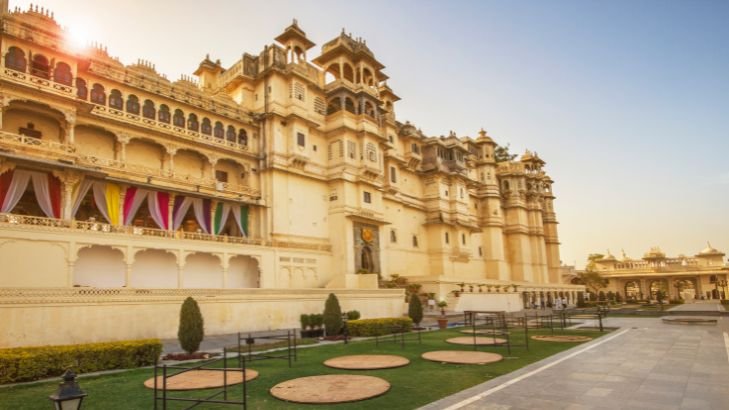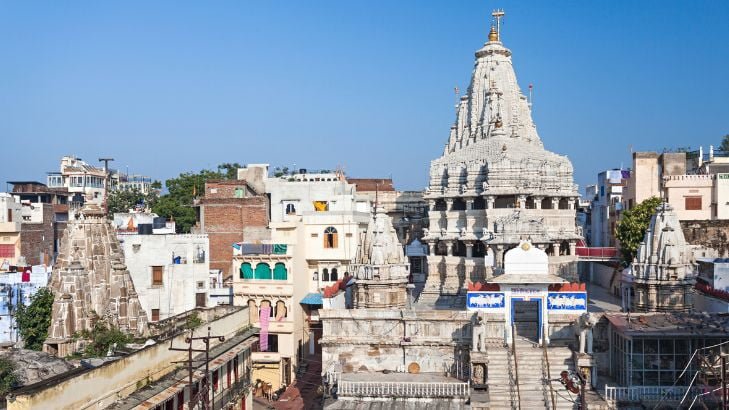Here’s the list of lakes, palaces, and temples you must visit in Udaipur.

As white cottony clouds in clear blue skies drift away to reveal white marble palaces and clean blue waters from a bird’s view, the city of Udaipur awakens at every sunrise with warmth and gleam that invite you to embrace its surreality.
“The City of Lakes”, “Kashmir of Rajasthan”, “Venice of the East” or the “White City of Rajasthan” is one of India’s most favourite holiday destinations alongside being one of the best locations for shooting films. If the verses of a ballad could be pulled out to build a romantic place, it would definitely be Udaipur – what with lakes and palaces, havelis and gardens, temples and paintings! This is a city where urban-scapes can be traded for palatial skylines.
The capital of the Kingdom of Mewar, bound by the Aravali mountains and founded by Uday Singh II of the Rajput clan, enjoyed a period of prosperity and supremacy between the 16th to the 19th centuries. This one-of-a-kind city leaves its visitors in awe even now for duly safeguarding the royal legacy and also for being culturally upbeat.
LAKES

The picture-book lakes of Udaipur do well to attract tourists from all over the globe – man-made and not natural, yet these crystal clear lakes are the foremost reason for which this ‘Jheelon ki Nagri’ rules the roost in popularity.
Lake Pichola: The biggest and most astounding lake of Udaipur was surprisingly not initiated by a king, but built by a Banjara tribesman in 1362. Later on, the surpassing beauty of Lake Pichola caught the fancy of the Maharanas who turned it into various purposes of pleasure, to symbolize their inner world of feelings and imagination, for example, the establishment of palaces in and around the waters, ‘ghats’ to celebrate festivals, sanctuary for birds and boating for amusement.
The Lake Palace and the JagMandir Palace that seem afloat are the key attractions on this lake for which it witnesses a heavy rush of people waiting in queues to catch a boat and ferry them across to get soaked in the scenic environment and to get them closer to these splendid palaces.
As of today, the banks of Pichola look clustered with too many heritage mansions, renovated havelis, lakeside restaurants and ghats buzzing with shops and activities. Despite this, it is still safe to say that it is Lake Pichola that makes the city of Udaipur so unique at every turn and no one can resist their desire to spend at least a day in the city full of ancient charms that no doubt appeal to everyone even in the modern day.
Fateh Sagar: Built in 1687 and named after Maharana Fateh Singh, besides being the second-largest lake in the city, draws people to three tiny ‘islands’, each of which houses a jet-water fountain, a solar observatory and Nehru park.
‘Saheliyon ki Bari’ is an impressive flower garden right on the banks of this lake which was built by Rana Sangram Singh II for his Queen in the 18th century. The garden layout is a fusion of Mughal and Rajput designs as seen in its multi-foliated arches, marble sculptures of elephants, rain fountains and a lotus pool.
Udai Sagar: Built in 1565 by Maharana Udai Singh by building a dam over the Berach river.
Swaroop Sagar: Built in the 1850s and named after Maharana Swaroop Singh, is located behind Jagadish Temple. It was made to balance the water levels of Pichola and Fateh Sagar lakes, in order to prevent flood threats, and hence a mini dam-like structure is visible on this lake.
RangSagar: Built in 1668 connecting Pichola and Swaroop Sagar lakes, also called as ‘Amarkund’.
PALACES

Palaces in Udaipur are a symphony of art and history; where time stands still in grandeur that once ruled the lands. Here’s where you can catch regality in every breath, witness the splendours of bygone monarchy and hear every wall resounding with chronicles of the past.
City Palace: One of the largest palaces not just in Rajasthan, but in entire India, the City Palace that supersedes definitions of flamboyance, was homogenously built with granite and marble, over a prolonged period of 400 years beginning from 1553 by Maharana Udai Singh II, to mark the shifting of his capital from Chittor to Udaipur and to mark the birth of his grandson Amar Singh I. Primly located on the east bank of Lake Pichola, the Palace is the focal point from where other stupendous monuments like Lake Palace, Jag Mandir, Monsoon Palace and Jagadish Temple can be seen. The palace is not just one building but an assembly of a great many structures constructed within, linked by several corridors, quadrangles, and gates (Pol):
- Amar Vilas: The highest point in the palace with hanging gardens
- Bada Mahal: A garden palace which is the main residence of the king
- Bhim Vilas & Krishna Vilas: Repositories of extraordinary Rajasthani miniature paintings
- Dilkhush Mahal: Known as the ‘Palace of Joy’
- Durbar Hall: Venue for official meetings with large chandeliers
- Fateh Prakash Palace: Now a luxury hotel
- Shiv Niwas Palace: A heritage hotel
- Laxmi Vilas Chowk: An art gallery
- Mor Chowk: The peacock courtyard
- Manek Chowk: Hall for a formal audience with porcelain decors
- Rang Bhavan: The royal treasury
- Sheesh Mahal: Known as the ‘Palace of Mirrors’
- Moti Mahal: Known as the ‘Palace of Pearls’
- Chitrashala: Known as the ‘Residence of Pictures’
Needless to say, the most significant among all would unarguably be the Gallery devoted to the legendary warrior Maharana Pratap, in the ‘Rajya Angan’ of the Palace. After Uday Singh II, the reigns of Udaipur passed on to his son Pratap Singh I. The 54th Mewar king is worshipped to this day in Rajasthan for his unshrinking spirit which drove him to wage courageous and heroic battles against the Mughals.
The gallery has an enormous painting representing the famous ‘Battle of Haldighati’ of 1576, where Maharana Pratap’s loyal white horse named Chetak can be seen wearing an elephant-faced mask. The disguise was cleverly devised to save the horse from malicious attacks by the enemy’s elephants. Other than that, the painting is a heart-wrenching visual of how the gallant horse fought equally bravely as his master even with a wounded leg. Maharana Pratap’s original armor weighing 72 kg and other weapons used by him during this battle are also exhibited.
[Haldighati is a narrow mountain pass 40 km away from Udaipur, so named due to the yellow colour of the mountain sand that seems like Haldi (turmeric)]Sajjangarh Palace: Perched on a peak in the Aravalis at a height of 3100 ft above sea level, overlooking the City Palace and the Lake Pichola, the palace was built with the notion of being an observatory to forecast the arrival of monsoons; however due to unforeseen circumstances during its construction, it could be at best be put to use only as another royal residence and a hunting lodge. A tour of the palace is recommended for mind-blowing panoramic vistas of Udaipur’s lakes and palaces from this vantage point.
Bagore ki Haveli: An eighteenth-century haveli commissioned by the then prime minister of Mewar, Amar Chand Badwa, once used to be a charming edifice of about a hundred rooms filled with frescos, coloured glasswork, and delicate mirror work. It is sad to state that the haveli has deteriorated over time, but recent restoration efforts have made it worth paying a visit for the museum-like displays of costumes, jewellery boxes, paintings, and copper vessels that dictated the lifestyle of Mewar’s ruling families.
All the more, nowadays the haveli has become the centre stage for conducting programmes of traditional Rajasthani dance and music in the evenings, when it is customarily lit with glowing lights to add on a special effect. People throng this area in the latter half of the day to enjoy a rendition of the cultural performances and also for a leisure stroll in the nearby Gangaur Ghat (where Gangaur fest usually happens.)
Jag Mandir Palace: Standing on a natural island in Lake Pichola, Jag Mandir/ “Lake Garden Palace”/ “Swarg ki Vatika”/Garden of Heaven, was an idea that came true on the whim of romance by the Maharanas of Mewar and was built in three stages by three rulers between the years 1551 to 1652. Purposed as a summer resort and as a place to hold lavish parties, the ‘floating’-like marble structure looks drop-dead gorgeous in the midst of the lake. It has been carefully and thoughtfully designed to look the most attractive with features like (i) the three-storeyed Gulmahal with three circular domes whose interiors are adorned with murals, (ii) an entry pavilion with a row of majestic stone-carved elephants with raised trunks as if in welcoming postures, (iii) a colonnade of arches facing the lake, (iv) residential suits, (v) Zenana (Queens’ chambers), (vi) courtyard with garden, (vii) Darikhana – an open terrace used as a lake-view restaurant at present, (viii) Jagriti – an onsite museum, (ix) Barah Patharon ka Mahal or the Palace of Twelve Stones {marble slabs} in the eastern wing and (x) Kunwar Pada ka Mahal or Palace of the Crown Prince in the western wing.
[JagMandir has a critical historical relevance in that, the GulMahal within it is said to have been the refuge of Emperor Shah Jahan during the 1620s when he rebelled against his father Jahangir in his quest to ascend the Mughal throne.So also, during the Sepoy Mutiny of 1857 against the British, Maharana Swaroop Singh is said to have given refuge to European women and children here.]
Today, the picturesque island palace caters to guests by offering all-day café-dining, bar and spa services. It is maintained by the HRH Group of Hotels and marketed as a glamorized luxe destination for carrying out weddings and other mega-events.
Lake Palace: Built in 1746, on Jag Niwas island in Lake Pichola spanning 4 acres, the Lake Palace is by all means luxury redefined that worked as a summer resort for the Mewar dynasty suggesting how life must have been enviably ‘milk and honey’ for these royals. Set like a magical fairy’s castle right in-between the freshwater body, the palace is adorned with marbles and semi-precious gems; that has been converted into one of India’s most expensive dream hotels efficiently managed by the well-acclaimed Taj group.
ALSO READ: Neelambari – An Eco-Vacation in Arattupuzha, Kerala [Travelogue]
TEMPLES

Temples in Udaipur are a testament to the fact that spiritualism runs visibly high in the blood of these people, who never allow their stringent beliefs to be overshadowed by the immense pride they hold in their hearts for their plenteous hereditament.
Shree Jagadish: An architectural bliss, this beautiful temple is of Lord Jagannath and has gained prominence with an ideal location adjacent to the City Palace in Old Udaipur. It was built in 1651 by Maharana Jagat Singh on a raised platform led onto by a fleet of 32 marble stairs. The main temple is a three-storeyed carved structure with a carved pyramidal spire above the sanctum. It is encircled by four other smaller temples within the same compound.
Karni Mata: A hilltop temple near Doodh Talai pond; deity here is believed to be an incarnation of Goddess Durga.
Eklingji: Situated in Kailashpuri village, an hour’s drive from Udaipur, this is quite a wonderful temple complex, one of the oldest Shiva temples in the district, which was built as early as 734 CE by none other than Maharana Bappa Rawal. It houses a 4-faced idol carved out of a single black stone and is nearly 50 feet tall.
Sahastrabahu: A 10th-century pair of temples each for Lord Vishnu and Lord Shiva, can be found in the Nagda village (23 km from Udaipur), en route to Eklingji temple. It is publically known as the Saas-Bahu temple as folklores suggest that a certain Kacchawa dynasty king constructed these temples for his wife and then later his daughter-in-law, where they both could worship their respective favourite deities.
Mahakaleshwar: A 900-year-old Mahakaal {Lord Shiva} temple, situated on the banks of Fateh Sagar Lake, noted for its grand ‘Mahashivratri’ celebrations.
Bohra Ganesh: About 350 years old, the Lord here is famous for miraculously solving ‘money’ issues of the devotees.
Neemach Mata: Another hill-top temple located on the banks of Fateh Sagar Lake, dedicated to Goddess Ambaji, the most revered deity of the Maharana clan.
ALSO READ: Essential Things To Carry For Your Rajasthan Trip in 2024!
